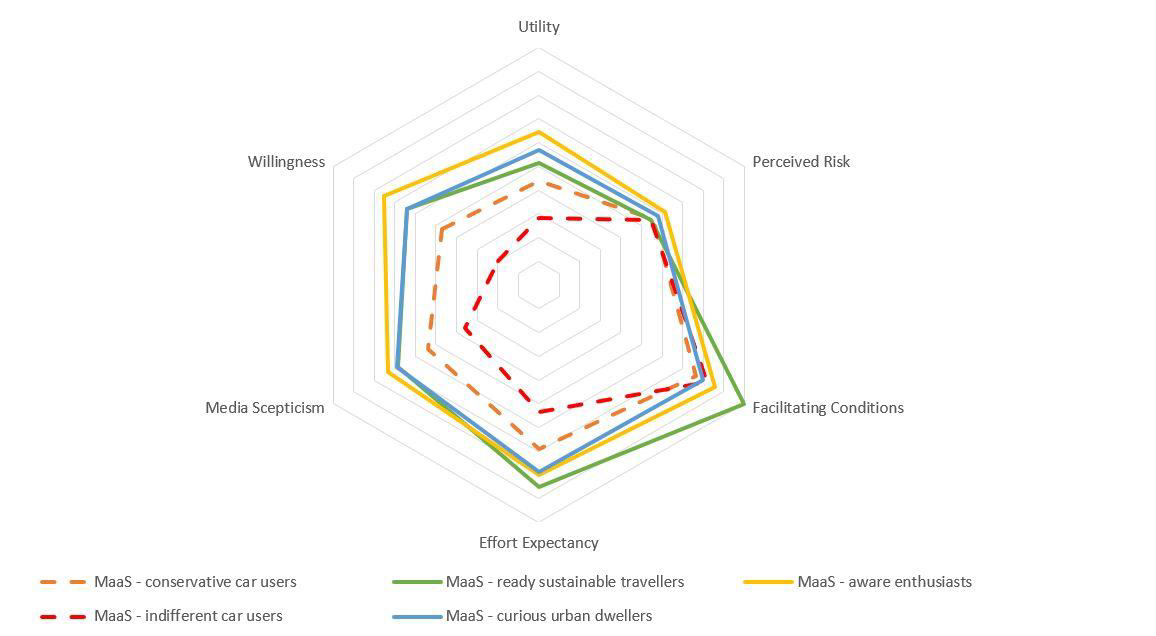Intention to use MaaS
Student information
Author: Renske van ’t Veer
Institution: Delft University of Technology
Graduation year: 2021
Vehicle-owners’ intention to use Mobility-as-a-Service
A latent class cluster analysis identifying factors behind the intention to use MaaS in the Netherlands
Increasing urbanisation and challenges regarding global sustainability mean that restructuring of current mobility and transportation systems is inescapable. One concept regarded as an answer to the changes needed is Mobility-as-a-Service (MaaS): an online platform which enables users to put together their optimal trip from a variety of transport modes, conventional and shared. MaaS only requires a single payment and provides up-to-date information about the desired trip. MaaS increases flexibility and ease of travelling, which is expected to have a positive effect on contemporary (urban) mobility.
As a relatively novel concept, MaaS has received considerable attention in academia as well as policy-making. In this body of literature, on the one hand MaaS is expected to improve the transport system, combat negative externalities of transportation, and positively impact social equity. On the other, the smart mobility solution is speculated to potentially be counterproductive by mostly replacing trips made by public transport and active transport modes. In this case, MaaS does not provide a solution to the changes needed in the current mobility and transportation systems, but contributes to the increasing number of vehicles on the road and related negative externalities.
Previous studies on the adoption potential of MaaS in the Netherlands have identified private vehicle owners as unlikely to adopt MaaS while individuals using environmentally-friendly transport modes are likely to adopt. In that case, MaaS might be more likely to negatively affect the Dutch transport system and society. Despite the discussions on the expected potential impacts of MaaS, uncertainties still remain about the impact on the transport sector and on the potential for individuals to adopt MaaS.
Successful implementation of MaaS, where the concept positively impacts the transport system and society as a whole, relies on public acceptance. As vehicle owners are currently identified as unlikely to use MaaS, insight into their motives which could influence their intention to use MaaS and contribute to its successful implementation were examined.
For this, a conceptual model was created in this research to provide an overview of potentially influential factors. Data was collected using a self-administered questionnaire which was distributed among individuals living in the Netherlands and owning or jointly owning a car. The constructs and relationships of the conceptual model were analysed and resulted in five factors, plus a sixth factor representing the vehicle owners’ willingness to use MaaS.
The research findings indicate that the overall willingness to use MaaS among vehicle owners is relatively low. The factor scores per cluster (see figure) show that clusters with a higher Willingness value also have a higher perceived utility and effort expectancy of MaaS. These clusters are consequently identified as intending to use MaaS. The perceived benefits in terms of convenience, travel time and travel costs of MaaS over current modes of travelling, similarities between MaaS and individuals’ habits as well as the perceived ease of using MaaS thus indeed influence the intention to use MaaS.
The results also show that vehicle owners intending to use MaaS have a higher concern about potential risks and more scepticism of external evaluations.

Cluster factor scores
The factors identified, as well as personal characteristics which influence vehicle owners’ intention to use MaaS, are mainly in line with previous research on the adoption potential of MaaS. Namely, clusters with a higher Willingness value have more younger vehicle owners, whereas clusters with a lower Willingness value have more vehicle owners aged 45 years or older.
An individual’s main mode of transport affects their intention to use MaaS. Vehicle owners whose main mode of transport is public transport, walking or cycling are better represented in the clusters intending to use MaaS. As also shown in previous studies, those with a higher level of education and living in a larger municipality also indicate a higher intention to use MaaS.
From the findings, it can be distilled that vehicle owners might not be the first in line to use MaaS once introduced, but this does not mean that vehicle owners will completely disregard the option of MaaS. The cluster profiles show that personal characteristics, such as the age, education level or experience with MaaS(-like) services also play a role.
Recommendations from this research include increasing individual familiarity with MaaS, for example with car-sharing services, as positive experiences with such services have a positive influence on intentions to use MaaS. Efforts in less densely populated areas have the most potential as the research results show that clusters not intending to use MaaS contain a large share of vehicle owners living in smaller municipalities, those inexperienced with vehicle-sharing schemes and who are unfamiliar with MaaS.
